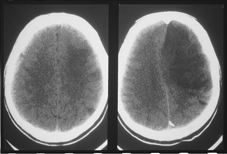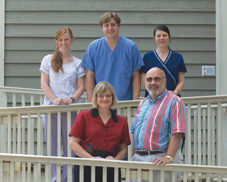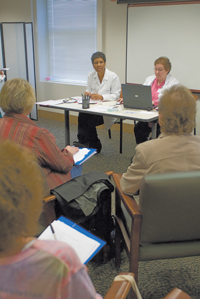Collaboration key to post-stroke follow-up
Post-stroke care often fragments after patients leave the hospital. Patients being treated by specialists should keep the primary care physician at the center of their follow-up regimen.
Stroke patients generally undergo intensive care and rehab immediately following an event, but unfortunately care often fragments later on, leaving patients and internists a little unsure about what's next.
“For many patients being treated by specialists, the primary care physician often isn't in the center of the web,” said Lee Schwamm, MD, vice chair of Massachusetts General Hospital and an associate professor of neurology at Harvard Medical School in Boston. “It's also difficult because boundaries regarding who is in charge of initiating or maintaining secondary-prevention strategies are unclear.”

For example, the neurologist may recommend a statin but not start the patient on it, assuming the internist will take over. That doesn't always happen, either because the internist didn't receive the recommendation or isn't aware that statins are now a first-line prevention treatment even in patients who don't have high cholesterol.
Dr. Schwamm suggested the best bet is to start the post-stroke regimen in the hospital.
“The data are starting to confirm that if you start the patients on lipid medications in the hospital, they're far more likely to be on them a year later,” he said.
Neurologist Bruce Ovbiagele, MD, director of the stroke prevention program at University of California, Los Angeles, agrees that communication between the primary care physician and the neurologist is critical in the early weeks following a stroke. But he acknowledges that it is often less than optimal.
For Dr. Ovbiagele, the wake-up call was a recent VA study that found that six months after stroke patients left the hospital, two-thirds had discontinued their antithrombotic medications.
“Often, the medications were discontinued by [primary care doctors] who thought there was no need for patients to stay on the therapy, even though it's really the cornerstone for preventing a second stroke,” Dr. Ovbiagele said. “They're dropping off [the medications] just at the time when the risk for recurrent stroke is very high.”
Research shows that risk of recurrence is highest in the week after an initial stroke one in 10 patients have a second stroke then but remains very high for a year and begins to drop off slightly after that. One in five stroke patients or individuals who've had a transient ischemic attack (TIA) have a second one within three months.
A study of more than 600 stroke patients, conducted in Italy a few years ago and published in Stroke (2007; 38: 2652-2657), found similar medication adherence issues. Within 12 months of discharge, nearly 40% of patients had discontinued their statins.
Optimizing care
The VA and Italian studies prompted Dr. Ovbiagele's Stroke PROTECT (Preventing Recurrence of Thromboembolic Events Through Coordinated Treatment) program to develop a handoff letter for patients or caregivers to carry to their internist or the next treating physician. The letter outlines the key evidence-based prevention strategies shown to markedly decrease risk for subsequent cerebrovascular events, including:
- using antithrombotics, an angiotensin-converting enzyme inhibitor and diuretics, and a statin to keep LDL cholesterol under 100 mg/dL,
- exercising, quitting smoking, and following the American Heart Association Diet; and
- calling 911 at the first sign of a recurrent stroke.
“The [primary care physicians (PCPs)] have found this letter very useful because many of them have not kept up to date on what's new with post-stroke treatment,” Dr. Ovbiagele said. Other resources include patient tracking forms, medication instruction sheets, patient self-tracking logs and calendars, and a patient report card.
The American Heart Association's 2007 Get with the Guidelines program created substantial improvements in pre-discharge treatment of stroke patients and use of the recommended medications. Other available resources include physician-focused tools, fact sheets, and evidence-based guidelines on stroke treatment and post-stroke management. Still, Dr. Ovbiagele said that practice variations and knowledge deficits persist.
Recent research has sparked changes about the most appropriate antiplatelet therapies after ischemic stroke, for example, and use of further physical therapy a year or more out from the stroke. Until recently, it was thought that using aspirin and clopidogrel in high-risk patients who've had a stroke or TIA was better than using a single antiplatelet agent.
That's no longer the case, said Samir Belagaje, MD, clinical instructor of vascular neurology and neuro-recovery at the University of Cincinnati and the Stroke Recovery Center at Drake Center. The MATCH study (Lancet, 2004; 364(9431):331) shows the combination is not better at reducing recurrence, and that using both significantly increases bleeding risk.
Similarly, new findings challenge the belief that physical therapy's benefits stop six months to a year after stroke. Dr. Belagaje said that recent studies have found that patients who return for additional rehab may improve, even several years later.
“We see a lot of patients who, after not being in therapy for several years, make more gains when they come back in for a ‘tune-up,’” he said. “Some of the things we thought about stroke and treatment even two years ago we now know aren't true, so communicating what we've learned about optimum management with the PCP community is important.”
The six-week follow-up visit, to either the primary care doctor or the neurologist, is especially important for patients on statins. Those patients should have their LDL levels checked to ensure statin dosing is effective, and should have liver function tested to make sure their liver enzymes aren't elevated. That potentially serious side effect occurs in roughly 2% of patients.
Dr. Ovbiagele added while the primary care physician should be monitoring statin use, in his system the neurologist often does it because some patients don't keep the appointment with the PCP. He added that some younger stroke patients or those who've had mild strokes may not realize the importance of follow-up when they're taking new medications.
“It's important to keep in mind that many patients weren't on any medications when they had their stroke, so that education and monitoring are crucial,” he said.
Timing the follow-up
Typically, if no active neurology issues persist, neurologists recommend that patients return to their internist within a few weeks of the stroke, even if they are seeing other specialists or are undergoing physical therapy or speech therapy. Some say that the sooner that happens, the better.
“My view is that patients should be returned to the internist immediately after discharge, because the bottom line is that the internist is the most important physician in preventing a first stroke or a second one,” said Barbara Scherokman, FACP, a neurologist with Kaiser in Northern Virginia who recently authored a curriculum on internist workup of common neurological symptoms, a joint project of ACP and the American Academy of Neurology. “They're really the best ones to take care of those risk factors.”
She also encourages internists to look for tests that might not have been done in the hospital, such as a swallowing study or the full complement of imaging studies, including carotid artery imaging and blood tests that may be needed to determine the stroke's etiology. That can be tricky with those under age 50 who've had cryptogenic strokes and don't appear to have any traditional risk factors, noted Dr. Scherokman, who is also a clinical professor of neurology at George Washington University in the District of Columbia.
In such cases, transesophageal echocardiography may be required in addition to transthoracic echocardiography to rule out or identify cardiac defects or thrombi that may contribute to stroke. An extensive thrombotic-risk blood panel may also be needed to rule out or identify hypercoagulable state, another potential cause of stroke in younger patients.
Practical ways to comanage
In Dr. Schwamm's experience, there is plenty of opportunity to improve coordination and reduce recurrence.
One way to improve care is a written document provided to all parties. “A concrete, formalized follow-up plan lends a lot of credence,” he said, “and of course there needs to be accountability at the physician and patient level.”
Dr. Schwamm also recommends using patient visits to check if patients are at goal with blood pressure and LDL, if feasible, and to reiterate the importance of secondary prevention measures.
“If the patient comes in for a respiratory infection, that's an opportunity to check on how they're doing with medications [adherence] and lifestyle issues diet, exercise, smoking, alcohol consumption,” he said. He urges internists to use a report-card approach to remind themselves to check risk factors and enlist patients in secondary prevention.
“It's not cookbook medicine,” he said. “It's a way to incorporate prompts to check on how patients are doing in reducing recurrence risk. Whether the patients are young or old, and whether they've had a minor or major stroke, the prevention strategies are the same.”
He added that although there's no standard endorsed post-stroke report card product at present, several pilots are under way.
Dr. Belagaje further recommends that the neurologist and internist communicate early on to ensure that they use the same message when talking about the importance of lifestyle changes and reducing the risk of recurrence. “I think that patients do better when they hear the same message from more than one physician,” he said.
Dr. Ovbiagele urges internists to stress secondary prevention to all post-stroke patients, even those who've had minor cerebrovascular events.
“Often the patient thinks that having a stroke is like a lightning strike, and it's a natural response,” he said. “That's why the internist needs to stress to patients that they're still at risk for another one, and that stroke is the third leading cause of death.”
The need to focus on recurrence prevention or secondary prevention is underscored by results of a recent study reported in Stroke (2009; 40: 1811-1819), which found that many patients who had suffered a first stroke were not receiving key prevention measures such as consistent antiplatelet use and regular exercise.
The study of more than 11,000 adults found that only 77% of patients took aspirin daily as prescribed, and only 57% exercised regularly. In addition, only two-thirds of patients with hypertension were counseled by a physician about dietary modifications and only two-thirds of smokers received cessation counseling.
The vast majority (90%) in the study had insurance coverage and a regular health care provider, and the researchers found no consistent care disparities in race, age, gender or residence in the “stroke belt,” 11 contiguous states in the southeastern U.S. that have stroke death rates more than 10% higher than the national average.
“Most usage rates for prevention services were between 50% and 70%, which means that a lot of people are not getting recommended care,” said the study's lead author, Joseph Ross, MD, MHS, of Mount Sinai School of Medicine in New York City. He added that the abysmally low rates of exercise, an important prevention strategy, should prompt internists to make counseling a high priority.
“The single most important thing a general internist can do when they first see a patient who has recently had a stroke is to explain what has happened and emphasize the important behavioral modifications the patient must make to lower risk,” he said. “These lifestyle changes are critical, and the internist cannot assume that this material was covered while the patient was hospitalized, when it would be hard for patients to remember all of the recommendations anyway, or that the patient's specialist or neurologist covered this material.”
He also recommends that internists reinforce the medication recommendations of the neurologist, and take the time to review new medications and clarify why they were prescribed. “That [discussion] might help identify any barriers that may lead to poor adherence,” Dr. Ross urged.




